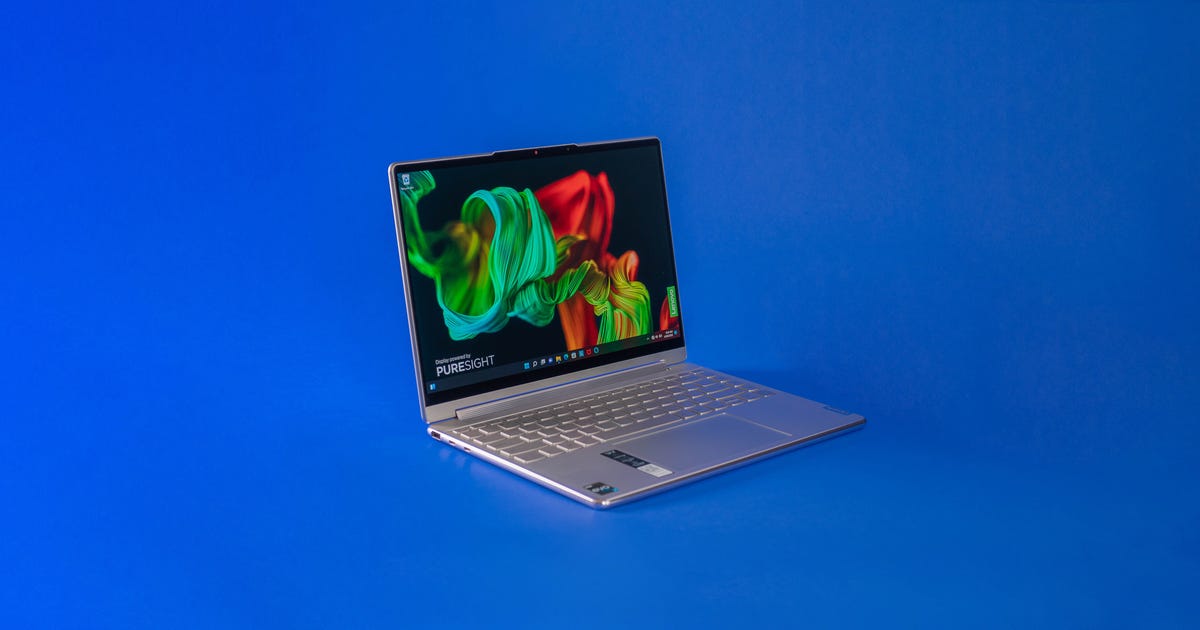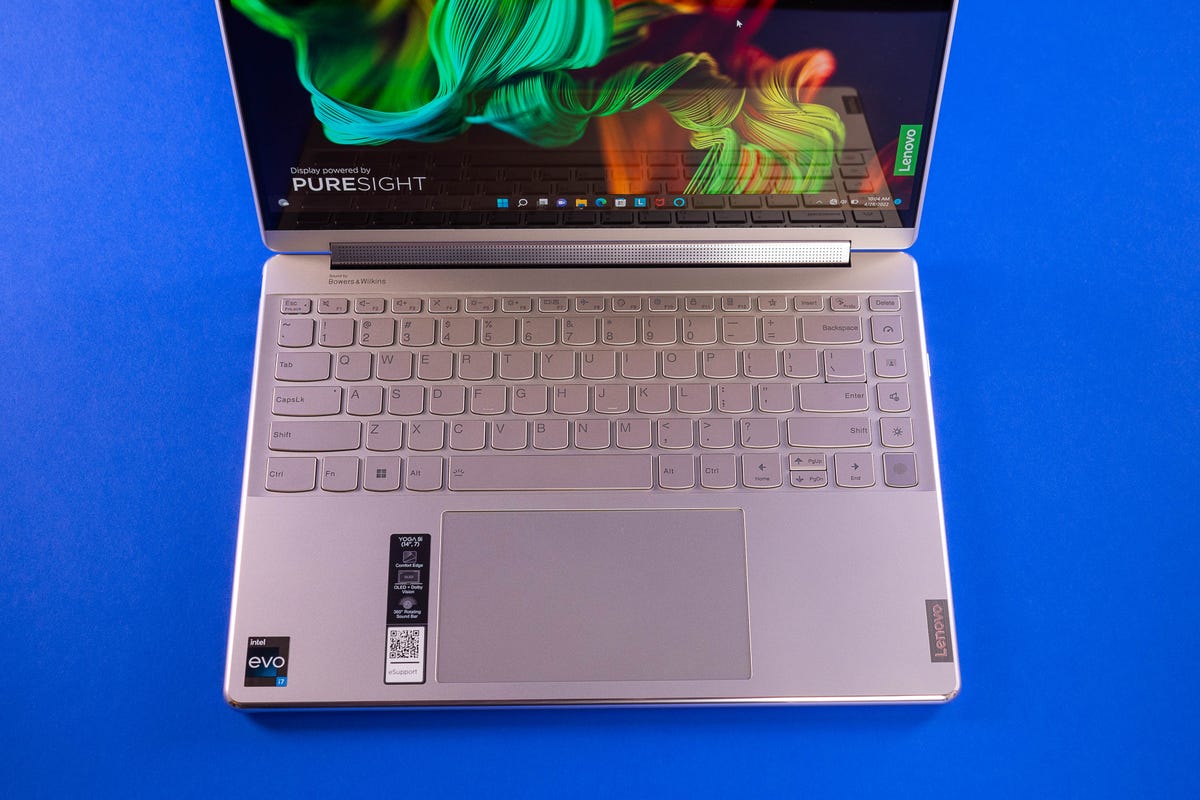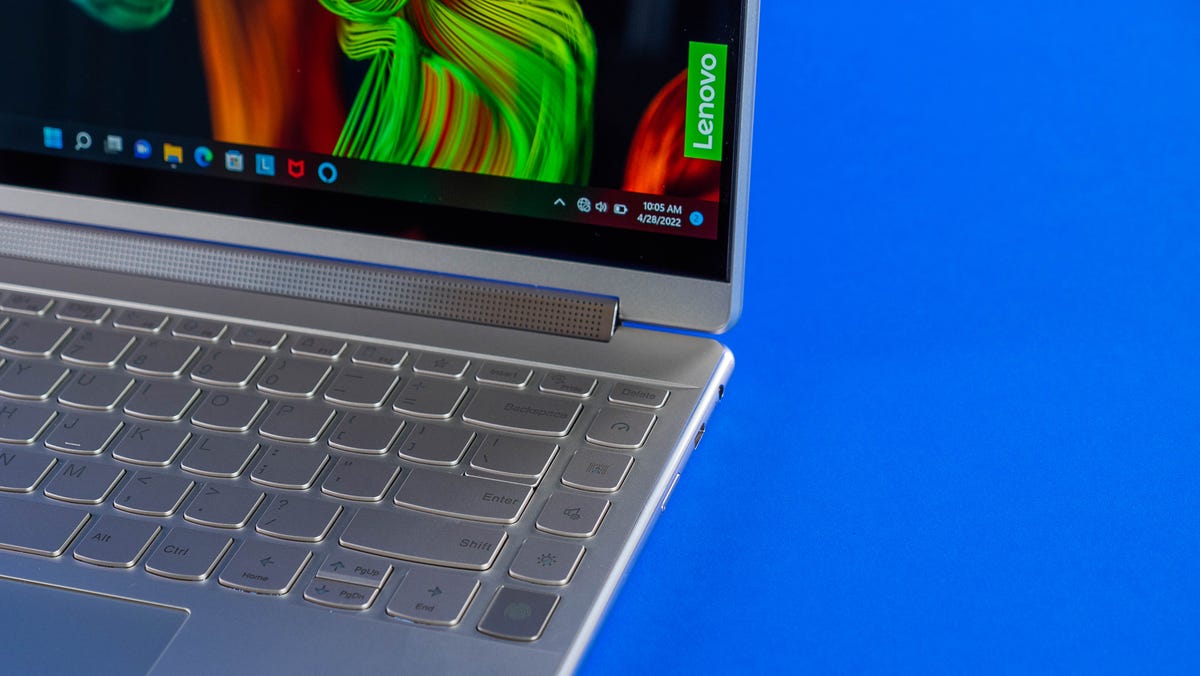Lenovo yoga 9i 14 inch reviews lenovo yoga 9i gen 7 release date lenovo yoga 9i 14 inch lenovo yoga 9i 14 review lenovo yoga 9i 14 dimensions lenovo yoga 9i gen 7 14 intel lenovo yoga 9i gen 7 uae lenovo yoga 9i gen 7 lenovo yoga 9i gen 7 test lenovo yoga 9i gen 6 lenovo yoga 9i gen 7 oatmeal lenovo yoga 9i 15

Lenovo Yoga 9i (Gen 7, 14-inch) Review: Pretty. Impressive.
Lenovo's Yoga line of two-in-ones is now 10 years old. It's not surprising the line has lasted this long: It was the best two-in-one design to come out with the launch of Windows 8. It's a laptop, a tablet, a digital whiteboard, a small all-in-one PC, an immersive mobile gaming display and a kitchen companion. All these years later, the Yoga's flexibility remains outstanding and Lenovo's flagship 14-inch Yoga 9i Gen 7 lets you take full advantage of that fact.
The design, display options and processors are all fresh for the Yoga 9i. Lenovo rounded off all the edges and corners on its aluminum body to make it more comfortable to carry and rest your wrists on while typing. Though I'm on the fence about the look of it (pretty, but there's something about it that seems dated), there's no denying how nice it is to not have the laptop edges digging into my wrists. And as with past Yoga 9-series models, everything looks and feels premium, right down to the included active pen and laptop sleeve.
The Yoga 9i has a premium price, too, assuming you can find one to buy. Lenovo has a base model Yoga 9i on its site for $1,080 (and occasionally it's even in stock) with an odd combo of a 12th-gen Core i7 paired with just 8GB of memory soldered on, a 256GB PCIe Gen 4 SSD and a 1,920x1,200-resolution display. The configuration I tested is decidedly higher-end with twice the memory and storage of that model plus a 2,880x1,800-resolution OLED display. It's a Best Buy exclusive for $1,730; as far as I can tell, it isn't listed on its website.
UK and Australia buyers fare much better with multiple configurations to choose from including the one reviewed here for £1,350 and AU$2,849. Availability has been and will continue to be an issue for the foreseeable future for all PC makers, not just Lenovo, which makes recommending anything difficult.
Lenovo Yoga 9i (14-inch, Gen 7)
| Price as reviewed | $1,730 (£1,350, AU$2,849) |
|---|---|
| Display size/resolution | 14-inch 2,880x1,800 OLED touch display |
| CPU | 2.1GHz Intel Core i7-1260P |
| Memory | 16GB LPDDR5 5,200MHz (soldered) |
| Graphics | 128MB Intel Iris Xe Graphics |
| Storage | 512GB PCIe NVMe Gen 4 SSD |
| Connections | USB-A 3.2 Gen 2, Thunderbolt 4 (x2), USB-C 3.2 Gen 2, 3.5mm audio jack, microSD card slot |
| Networking | 802.11ax (Wi-Fi 6E), Bluetooth 5.2 |
| Operating system | Windows 11 Home 21H2 |

The 2.8K OLED display is easy on the eyes.
Joshua Goldman/CNETLots to look at
Lenovo offers the Yoga 9i with three 16:10 touchscreen options: a full-HD LCD with 100% sRGB color gamut, and a 2.8K OLED or 4K OLED with 100% P3 color gamut. The 2.8K OLED is a good balance between performance and pure eye candy, covering 100% sRGB, 99% P3, 98% Adobe RGB and 95% NTSC color gamuts. Though Lenovo rates its brightness at 400 nits, I measured it at 354 nits. However, switched into HDR mode, the peak brightness is 617 nits. It can also be switched from 60Hz to 90Hz for smoother-looking fast movement.
Mind you, none of this improves battery life, which came in at 10 hours, 31 minutes on our streaming video test with HDR off, the refresh rate at 60Hz and brightness and audio through earbuds set at 50%. That's not bad, and it charges fast via a USB-C port. If better battery life is necessary, though, opt for the full-HD LCD.

The keyboard and larger touchpad are a pleasure to use.
Joshua Goldman/CNETThe hybrid life
With more people working remotely now, PC makers have been forced to make some long-overdue changes to laptops... namely improvements to webcams, mics and audio. The Yoga 9i Gen 7 has a good 1080p webcam paired with an IR camera and dual far-field microphones. The IR camera is for signing in with facial recognition. But the Yoga 9i also has presence detection, a feature first found on ThinkPad business laptops.
If you walk away from the laptop, it will automatically lock itself down. When you return, the Yoga 9i senses your presence and starts looking for your face to unlock it instantly. The feature can even be used to pause video playing on the display when you leave and resume upon return when using certain players like VLC. There's also a physical webcam shutter for privacy when you want it.
Lenovo also added a row of shortcut keys down the right side of the keyboard. These one-click Function keys give you direct access to four features designed to make it easier to use the 9i for hybrid work or learning. There's a key that controls your fans for quiet or increased performance, one that instantly adds a background blur when you're using a video conference app and another for choosing audio profiles for music, gaming or movies.

There's a fingerprint reader at the bottom of the one-click Function keys.
Joshua Goldman/CNETWith Dolby Atmos support and the Yoga 9i's 360-degree soundbar hinge with quad Bowers & Wilkins speakers (two woofers and two tweeters), all of those modes have some of the best sound quality I've heard from a laptop, especially one so thin. However, the speakers do vibrate the chassis and you can feel it in the palm rests. It didn't bother me much, because I typically listen to music with headphones while working and my hands aren't usually on the keyboard when watching videos. But I could see how someone might find the vibration irritating while typing.
The fourth key is for quickly flipping between light and dark modes in Windows 11. This might seem kind of silly, but if you get the Yoga 9i with one of its OLED display options, dark mode is a good way to conserve battery life. Below that is a fingerprint reader for quick sign-ins if you don't use facial recognition.
To my surprise, I ended up using all of the one-click Function keys way more than I thought I would. The background blur key in particular. Lenovo also packs some similarly handy features into its Vantage software. It's where the presence-detection settings mentioned earlier are found as well as options for cooling, power, audio, display and camera and wireless network performance. However, as helpful as it is, it's also the company's avenue for pitching you on various partner services.

Things like SurfEasy VPN, McAfee LiveSafe, DashLane password manager and Lenovo's own Smart Performance service for $30 a year, which scans your PC and fixes any issues it finds. This is also where you'll get offers for extended warranties for the laptop and battery. It's aggravating but I suppose it's better than having all of these preinstalled. Only the McAfee software is preinstalled and it should probably be the first thing uninstalled for its annoying pop-ups alone.
The Lenovo Yoga 9i Gen 7 continues the company's streak of fantastic premium two-in-ones. The 12th-gen Intel processor delivers a big performance jump in multicore tasks compared to its predecessor, and the features and design are worth the higher price.
Now if only it was available to buy...
Geekbench 5 (multicore)
Samsung Galaxy Book 2 Pro 360 15
Lenovo Yoga 9i (14-inch, Gen 7)
Dell Inspiron 7415 2-in-1
Lenovo Yoga 9i (14-inch, Gen 6)
Note:
Longer bars indicate better performanceCinebench R23 CPU (multicore)
Samsung Galaxy Book 2 Pro 360 15
Dell Inspiron 7415 2-in-1
Lenovo Yoga 9i (14-inch, Gen 7)
Lenovo Yoga 9i (14-inch, Gen 6)
Note:
Longer bars indicate better performancePCMark 10 Pro Edition
Lenovo Yoga 9i (14-inch, Gen 7)
Samsung Galaxy Book 2 Pro 360 15
Dell Inspiron 7415 2-in-1
Lenovo Yoga 9i (14-inch, Gen 6)
Note:
Longer bars indicate better performance3DMark Wild Life Extreme
Samsung Galaxy Book 2 Pro 360 15
Lenovo Yoga 9i (14-inch, Gen 7)
Samsung Galaxy Book Pro 360 15
Note:
Longer bars indicate better performanceStreaming video playback battery drain test (minutes)
Lenovo Yoga 9i (14-inch, Gen 6)
Samsung Galaxy Book 2 Pro 360 15
Dell Inspiron 7415 2-in-1
Lenovo Yoga 9i (14-inch, Gen 7)
Note:
Longer bars indicate better performanceSystem Configurations
| Razer Book 13 (late 2020) | Microsoft Windows 10 Home (64-bit); 2.8GHz Intel Core i7-1165G7; 16GB DDR4 SDRAM 4,267MHz; 128MB Intel Iris Xe graphics; 256GB SSD |
|---|---|
| Asus ZenBook Duo 14 UX482 | Microsoft Windows 10 Home (64-bit); 2.8GHz Intel Core i7-1165G7; 8GB DDR4 SDRAM 4,267MHz; 128MB Intel Iris Xe graphics; 512GB SSD |
| Lenovo Yoga 9i (14-inch) | Windows 11 Home 21H2; 3.0GHz Intel Core i7-1185G7; 16GB DDR4 SDRAM 4,267MHz; 128MB Intel Iris Xe graphics; 512GB SSD |
| Acer AP714-51T Porsche Design Acer Book RS | Microsoft Windows 10 Home (64-bit); 2.4GHz Intel Core i5-1135G7; 8GB DDR4 SDRAM 4,267MHz; 128MB Intel Iris Xe graphics; 512GB SSD |
| Asus ZenBook 13 UX325EA-AH77 | Microsoft Windows 10 Pro (64-bit); 2.8GHz Intel Core i7-1165G7; 16GB DDR4 SDRAM 4,267MHz; 128MB Intel Iris Xe graphics; 1TB SSD |
| HP Envy x360 13 (2020) | Microsoft Windows 10 Home (64-bit); 2.3GHz; AMD Ryzen 5 4500U; 8GB DDR4 SDRAM 3,200MHz; 512MB Radeon graphics; 256GB SSD |
Source
Blog Archive
-
▼
2023
(62)
-
▼
January
(40)
- Dell XPS 17 9720 (2022) Review: Creative, With A S...
- WWE Elimination Chamber 2022: Start Times, Full Ca...
- Lenovo Yoga 9i (Gen 7, 14-inch) Review: Pretty. Im...
- What To Know About Omicron And Its Subvariants (In...
- Lorex 2K Pan-Tilt Indoor Security Camera Review: E...
- Which Smart Home Gadget Should You Buy First?
- Royal Caribbean Cruise Ships To Get SpaceX Starlin...
- Microsoft Says Android Apps Won't Be Available For...
- Windows 11 Looks A Little Different. Here's What's...
- Google's $100 Million Settlement: There's Still Ti...
- Ford F-150 Lightning Pro SSV Is Ready For Silent P...
- Google Sued By Multiple States Over How It Handles...
- Smartphone Shipments See Record Drop As Coronaviru...
- Dell XPS 13 (winter 2013) Review: Still Can't Touc...
- MultiVersus: You Can Now Play As Morty From 'Rick ...
- Chromebooks Have An Expiration Date. Here's How To...
- Scientists Read 300-year-old Sealed Letter Without...
- Move Your Toddler Into A Big Kid Bed With These 5 ...
- Thor Star Will Run Wild As WWE's Hulk Hogan In New...
- Google Sues Sonos Over Voice Control Technology
- Panic's Playdate Feels Like A Delightful, Bizarro ...
- Cadillac Will Hand-Build The Celestiq EV In Michigan
- Deadmau5 Headlines Trippy Interactive Music Journe...
- Meta Warns Of Pulling Facebook And Instagram From ...
- 'The Umbrella Academy' Season 3: Ending Explained,...
- $55,000 Honda Civic Si FE1 Is An Accessible Turnke...
- Apple WatchOS 9's New Features Include Sleep Track...
- Best Chromebook Deals: 9 Picks For Students From A...
- Refurbished IPads Are Available At Steep Discounts...
- Maya Hawke, Camila Mendes Team Up In 'Do Revenge' ...
- Why The Galaxy S22 Is So Important To Our Freedom ...
- Barry Watson Helps Reboot The Superhero Genre In T...
- Lenovo ThinkPad X12 Detachable Review: Solid Surfa...
- WhatsApp, Kik, Viber Or ReTXT: Which Third-party M...
- OnePlus 10T Gets A Little Faster By Sacrificing A Lot
- S21 Ultra Vs. S20 Ultra: Samsung Galaxy Camera Sho...
- Who Is WhatsApp Co-founder And CEO Jan Koum?
- Asus ZenBook Duo 14 UX482 Review: A Dual-screen La...
- Garmin Intros New Cycling Radar With Integrated Ca...
- Samsung's Cheaper Galaxy A Phones Get The Spotligh...
-
▼
January
(40)
Total Pageviews
Search This Blog
Popular Posts
-
Soalan matematik latih tubi tahun, soalan matematik latihan upsr, soalan matematik latihan, soalan matematik tahun 5, soalan matematik tingk...
-
Resepi roti guna breadmaker, resepi roti guna tepung gandum, resepi roti guna kitchen aids, resepi roti guna bread maker, resepi roti jala, ...
-
Resepi homemade coklat, resepi fondant homemade recipe, resepi homemade meatball, resepi homemade burger, resepi homemade pizza, resepi home...

